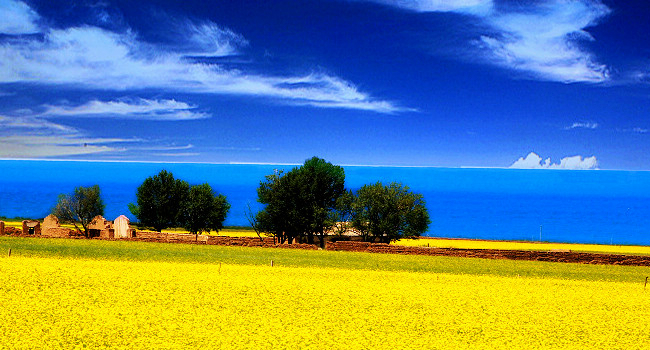1.Qinghai Lake
Qinghai Lake, "a blue sea" in Mongolian and Tibetan, is the largest inland salt lake in China, covering an area of 4,500 square kilometers (450,000 hectares). With an average depth of 20 meters, the lake is known for its vast expanse of misty and wavy blue water.
Around the lake is the an endless stretch of picturesque grasslands, rapes and wheat fields. Countless sheep, cattle and horses are grazinggraze under the white cloud-dotted blue sky.

The most fascinating attraction of Qinghai Lake is the Bird Island, a sanctuary for many kinds of birds, which is one of China's eight key bird nature reserves. Covering an area of 0.11 square kilometers (11 hectares), the island provides habitats for over 100,000 migrating birdsnts from south China and Southeast Asia. Such a density is rare in the world. If you want to join China tour packages to Qinghai, Qinghai Lake is a must-see attraction.
The splendid scenery of Qinghai Lake has attractedattracts millions of tourists. May, June, and July are the best months to go and see the birds.
Admission:270 yuan (US$42.38)/person
2. Kanbula National Forest Park
Located in Huangnan Tibetan Autonomous Prefecture, 131 kilometers (81.4 miles) from Qinghai’s capital city Xining, the Kanbula National Forest Park is an ideal place for traveling, sightseeing, vacation, camping and scientific expeditions.

Covering an area of 152 square kilometers (15,200 hectares), the park is famous for its unique landform of red gravel rocks, and features forest vegetation, lofty mountains, soaring peaks crystal water and Tibetan culture. With an altitude of 2,100 to 4,000 meters above sea level, it borders on the Yellow River in the north and is close to Lijiaxia Hydropower Station.
The weather amid the mountains can change very frequently.
Admission:87 yuan (US$13.66)/person
3. Ta'er Lamasery
Located 25 kilometers (15.53 miles) southwest to Xining City, the Ta'er Monastery is one of six famous monasteries in the Gelugpa Sect (also called Yellow Hat Sect) of Tibetan Buddhism. It is said to be the birthplace of Zongkaba (1357-1419), the founder of the Gelugpa Sect.

Founded in 1379, the lamasery has a history of more than 600 years. It sits on the slopes of a mountain, covering an area of 600 mu (40 hectares). With a combination of Tibetan and Han architectural styles, it is a complex that embraces 9,300 structures, including scripture halls, Buddha halls, lamas' residences, and Buddhist pagodas. If you want to know something about Tibetan Buddhism, you can visit Ta'er Lamasery instead of Tibet travel Butter sculptures, mural paintings and embroidery are three spectaculars specialties of the Ta'er Lamasery.

Admission: 80 yuan (US$12.56)/person
No comments:
Post a Comment